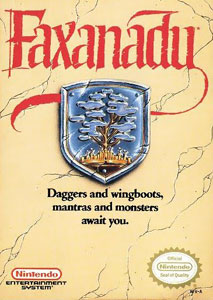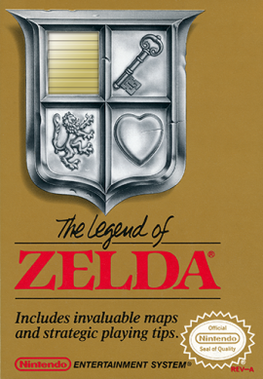
The Legend of Zelda, originally released in Japan as The Hyrule Fantasy: Zelda no Densetsu, is an action-adventure game developed and published by Nintendo. The first game of The Legend of Zelda series, it is set in the fantasy land of Hyrule and centers on an elf-like boy named Link, who aims to collect the eight fragments of the Triforce of Wisdom in order to rescue Princess Zelda from Ganon. During the course of the game, the player controls Link from a top-down perspective and navigates throughout the overworld and dungeons, collecting weapons, defeating enemies and uncovering secrets along the way.

River City Ransom, known as Street Gangs in PAL regions, is an open world action role-playing beat 'em up video game originally for the Nintendo Entertainment System. It is an English localization of Downtown Nekketsu Monogatari for the Famicom. The game was developed by Technōs Japan and released in Japan on April 25, 1989.

Dragon Slayer is a series of role-playing video games by Nihon Falcom. The first Dragon Slayer game is an early action role-playing game, released in 1984 for the NEC PC-8801 and ported by Square for the MSX. Designed by Yoshio Kiya, the game gave rise to a series of sequels, most of them created by Falcom, with the exception of Faxanadu by Hudson Soft. The Dragon Slayer series is historically significant, both as a founder of the Japanese role-playing game industry, and as the progenitor of the action role-playing game genre.
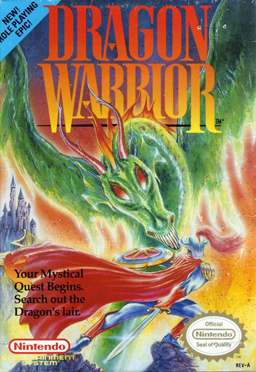
Dragon Quest, titled Dragon Warrior when initially localized to North America, is a role-playing video game developed by Chunsoft for the Nintendo Entertainment System. It was released by Enix in Japan in 1986 and by Nintendo in North America in 1989. It is the first game in the Dragon Quest video game series. Dragon Quest has been ported and remade for several video game platforms, including the MSX, MSX2, PC-9801, Super Famicom, Game Boy Color, Nintendo 3DS, PlayStation 4, mobile phones, and Nintendo Switch as of 2019. The player controls the hero character who is charged with saving the Kingdom of Alefgard and rescuing its princess from the evil Dragonlord. Dragon Warrior's story became the second part in a trilogy, with several spinoff anime and manga series.
Bonk, known as PC-Genjin in Japan and as PC Kid or BC Kid in PAL territories, is a video game character and former mascot for NEC's PC Engine/TurboGrafx-16 video game console. Three platform games featuring the character appeared on the PC Engine/TurboGrafx-16, as well as two spin-offs featuring Air Zonk. The protagonist is a bald caveman named Bonk who attacks using his comically large head.
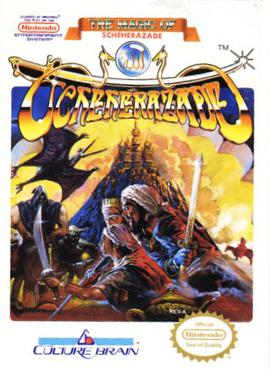
The Magic of Scheherazade is an action-adventure/role-playing video game (RPG) developed and released by Culture Brain for the Nintendo Entertainment System (NES). The game was released in 1987 in Japan and 1990 in North America. The plot is based on Middle Eastern folktales found in One Thousand and One Nights. It involves an amnesic hero traveling through time in an attempt to rescue the princess Scheherazade from the evil wizard Sabaron, who has summoned a horde of demons to bring chaos to the once peaceful land of Arabia. The Magic of Scheherazade is divided into chapters and incorporates elements of both action-adventure and RPG gameplay styles. In each chapter, the player character can freely explore an overworld in a top-down perspective. The player engages hostile enemies with various weapons and spells through both real-time solo action on the overhead map and random, turn-based battles fought alongside befriended allies.
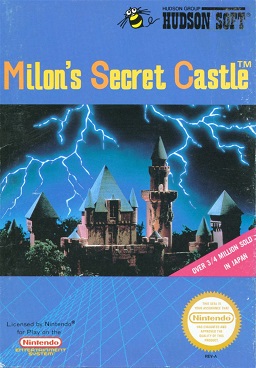
Milon's Secret Castle, known in Japan as Meikyū Kumikyoku: Milon no Daibōken, is a 1986 action-adventure game released by Hudson Soft for the NES. A Game Boy version was released in 1993. A sequel, DoReMi Fantasy, was released in 1996 for the Super Famicom.

Hudson's Adventure Island, known as Takahashi Meijin no Bōken Jima in Japan and also known as Adventure Island, is a side-scrolling platform game produced by Hudson Soft that was released in Japan for the Famicom and MSX on September 12, 1986. Adventure Island was released in North America for the Nintendo Entertainment System in 1988 and in the PAL region in 1992.
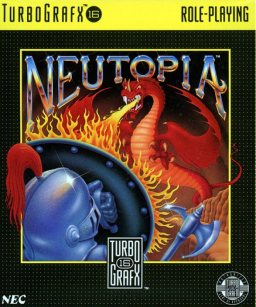
Neutopia is an overhead action-adventure video game developed by Hudson Soft. It was released by Hudson for the PC Engine in Japan on November 17, 1989. It was then released by NEC for the TurboGrafx-16 in North America in 1990. It was re-released for the Virtual Console service worldwide for the Wii in 2007; it was re-released for the PlayStation Network in Japan in 2010 and in North America in 2011. It was re-released for the Wii U on April 16, 2014 in Japan, and in USA and Europe in 2017. The game takes place in the land of Neutopia, where the evil demon Dirth has captured Princess Aurora and has stolen the eight ancient medallions which contain the wisdom and power necessary to maintain peace and prosperity throughout the land. It is up to the protagonist Jazeta to retrieve the eight medallions, defeat Dirth, rescue Princess Aurora, and save the land and its people.

Rygar is a side-scrolling platform game created by Tecmo in 1986 and originally released for arcades in Japan as Argos no Senshi. The player assumes the role of a "Legendary Warrior", battling through a hostile landscape. The main feature of gameplay is the use of a weapon called the "Diskarmor", a shield with a long chain attached to it.
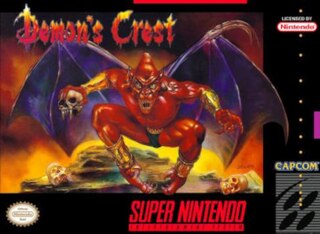
Demon's Crest, known in Japan as Demon's Blazon, is a side-scrolling platform video game developed and published by Capcom for the Super Nintendo Entertainment System. It is the third video game starring Firebrand, following Gargoyle's Quest and Gargoyle's Quest II.
The Virtual Console is a line of downloadable video games for Nintendo's Wii and Wii U home video game consoles and the Nintendo 3DS family of systems.
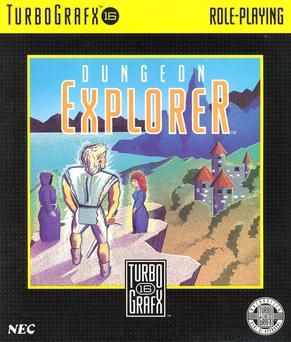
Dungeon Explorer is an action role-playing video game developed by Atlus for the TurboGrafx-16 and originally published by Hudson Soft in Japan on March 4, 1989, and later in North America by NEC on November 15 of the same year. The first installment in the eponymous franchise, the game is set in the land of Oddesia, which has been overrun by an alien race and where players assume the role of one of eight main characters tasked with recovering the Ora stone to kill the alien king Natas. Co-directed by Kazutoshi Ueda and Yōsuke Niino, the title was created by most of the same team that would work on later several projects such as entries in the Megami Tensei series. Though it was initially launched for the TurboGrafx-16, it was later re-released through download services for various consoles.

Legacy of the Wizard, originally released in Japan as Dragon Slayer IV: Drasle Family, is a fantasy-themed action role-playing platform game released for the MSX, MSX2 and Famicom in Japan and for the Nintendo Entertainment System in the United States. Legacy of the Wizard is an installment in Falcom's Dragon Slayer series, and one of only five Dragon Slayer games that were localized outside Japan. The game was an early example of an open-world, non-linear action RPG, combining action-RPG gameplay with what would later be called "Metroidvania"-style action-adventure elements.

Sorcerian is a 1987 action role-playing game developed by Nihon Falcom as the fifth installment in the Dragon Slayer line of games. Originally released for the PC-8801 Personal Computer, it has since been released on a wide variety of platforms.
While the early history and distinctive traits of role-playing video games (RPGs) in East Asia have come from Japan, many video games have also arisen in China, developed in South Korea, and Taiwan.

Final Fantasy is a fantasy role-playing video game developed and published by Square in 1987. It is the first game in Square's Final Fantasy series, created by Hironobu Sakaguchi. Originally released for the NES, Final Fantasy was remade for several video game consoles and is frequently packaged with Final Fantasy II in video game collections. The first Final Fantasy story follows four youths called the Warriors of Light, who each carry one of their world's four elemental crystals which have been darkened by the four Elemental Fiends. Together, they quest to defeat these evil forces, restore light to the crystals, and save their world.
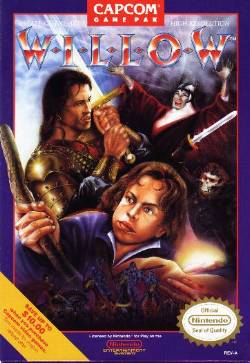
Willow is a 1989 2D action role-playing game developed and published by Capcom for the Nintendo Entertainment System. It is loosely based on the 1988 film of the same name and is the second title Capcom released based on Willow that year, the first being an unrelated side scrolling arcade game. The version of Willow released for the Nintendo Entertainment System and the Famicom is an adventure game in the vein of The Legend of Zelda.
